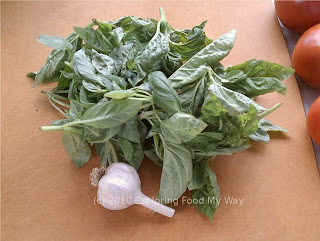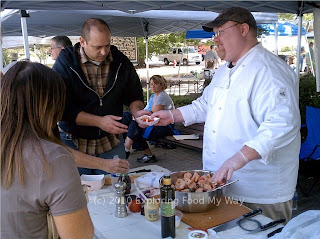I thought about it over the weekend and decided that I didn't want to get into anything nearly as complicated as I did for my previous demonstration. I did some research on panzanella salads on the Internet and pretty much came to the conclusion that other than day old bread and fresh tomatoes, panzanella salad was pretty much an open book. Dressed with a fresh vinaigrette, this was a salad designed at its very core to use ingredients both leftover and fresh. I agreed to do the demonstration and on the morning of Saturday, September 25th, I showed up about an hour earlier than necessary to set up my station, gather the necessary bowl, cutting board and metal spoon from the cooking school, and make my rounds to the various vendors, gathering the few simple ingredients I would need today to make my salad.
So let's talk about the primary players in today's demonstration. First up were two day-old baguettes that I managed to secure from Great Lakes Baking Company:

From one of the Amish vendors, I bought three pints of very red and very ripe tomatoes:

Between this vendor and another one, I also managed to add some red onions and Asian eggplants to the mix:

The final fresh components came from one of the vendors offering fresh organic basil and garlic:

To prepare the salad, first I used my paring knife to core all of the tomatoes. I then switched to my chef's knife and did a rough dice of all the tomatoes. Since panzanella is a rustic salad, there was no need for a fine dice on any of the ingredients. After cutting all of my tomatoes and adding them to my mixing bowl, I turned my attention to the two medium-sized red onions. After peeling each, I cut them both into a rough dice as well, discarding the root ends. My general rule of thumb in vegetable preparation today was to try and cut all of the vegetables to the same size.
Since the Asian eggplant was long and slender (you could also use regular eggplant, too), I cut them into "coins" and then cut the larger coins in half where necessary. The Asian eggplant had a bit of a slight bitterness to it that I hoped would match well to the sweetness from the ripe tomatoes and the acidity from the vinaigrette. If there was one surprising item that I learned from today's demonstration, it was the fact that so many people didn't realize that you can eat eggplant raw. I can't count the number of times I heard, "Wait, you added raw eggplant?"
The small bulb of garlic I had purchased during my earlier shopping spree yielded about five good-sized cloves that I smacked with the side of my knife to release the paper husk. I then sliced the individual cloves thinly before adding them to my mixing bowl. For the final "fresh" ingredient, the basil, I picked the tender leaves from the stems, piled them up on my cutting board and used my knife to slice them into thin ribbons. Had the amount of leaves I needed been much smaller, I would have stacked the leaves, rolled them up and done a proper chiffonade on them. Since I had a limited amount of time before serving today's market-goers, I did a simpler, more rustic cut. I added the fresh basil to the mixing bowl and turned to the other star of the show: the bread.
Switching to my trusty serrated bread knife, I began thinly cutting the baguettes, probably about 1/8" thick. After slicing through one and a half baguettes, I stacked four or five of the slices on top of each other and cut the entire stack in half so that they were a similar size to the already cut up vegetables. I have also seen versions of this salad where the bread was torn from the loaf, sort of free form. I think either way will work just fine. I added all of the sliced and cut bread to the mixing bowl and began the final step of assembling the salad, building the red wine vinaigrette.
Here were the ingredients I used today to build my red wine vinaigrette:

The wonderful thing about vinaigrettes is that at its most basic you need oil, vinegar, Dijon mustard, salt and pepper ... that's it! And even the mustard is optional in a real basic vinaigrette. The Dijon mustard actually plays two roles in this particular vinaigrette. First, I love the bit of heat that the prepared mustard adds to the finished dressing. Second, mustard seeds contain a natural substance called lecithen which actually acts to emulsify the dressing so that the oil and vinegar don't separate after mixing.
To the small mason jar in the above photograph, I added two healthy spoonfuls of mustard, three nice pinches of kosher salt, several grinds of freshly cracked black peppercorns and enough red wine vinegar to go about one third of the way up the jar. I then added enough extra virgin olive oil until it was about three-quarters full. I placed the lid on the jar and screwed the cap down firmly, shook vigorously and tasted. I wanted a dressing that was tart, but not overly so. From this point it is all about adjusting the flavor to your taste. If it is too oily, add more vinegar; too tart, add more oil. It took about two or three adjustments of adding oil and salt before I got it to the perfect level.
I added the entire contents of the jar to my mixing bowl along with a nice pinch of sea salt and more freshly cracked black pepper, grabbed the large metal spoon and began to gently toss the salad, scooping from the bottom of the bowl and lifting to the top. I wanted to make sure that I was gentle so that I didn't break the ripe tomatoes down too much as I mixed. How did I know when the salad was ready? Basically, once the bread absorbed the vinaigrette and the juice that had come out of the tomatoes, it softened up a bit. At that point, I tasted it for seasoning, made some corrections, and ended up with this:

At this point I looked up and realized that quite the crowd had gathered round the demonstration booth. I knew that we needed to get the samples out as quickly as possible. Using the cardboard containers that the market's manager, J Hudson, had supplied, he and I quickly did an assembly line style plating and handed the dishes out to eager patrons:

What had taken me about forty-five minutes to prepare took only twenty minutes to plate and serve. Honestly, given the size of the salad I had made, I was a little surprised it went so quickly. Once the bowl was completely empty, I fielded any remaining questions from the crowd and began to clean up and break down my station. I'm not exactly sure how many samples we handed out today at the market, but if I had to guess, it was probably somewhere between 40 and 50. Of course, you are certainly free to scale the amounts I used today up or down to feed the number of hungry mouths you have on hand.
Sadly, we are nearing the end of the picking season for this year. That being said, you still have a couple more weeks to get to the Hudson Farmers Market (or whatever market is closest to you) if you want to try out this salad. The tomatoes really do need to be at their peak of ripeness, so if you wait too long, it won't be until next summer before you have another shot at making this tasty and fresh salad.
[Ed. note: A quick thank you to Chef Brian from Hudson's Restaurant on the Green for helping me to expedite some of the samples handed out today.]

No comments:
Post a Comment